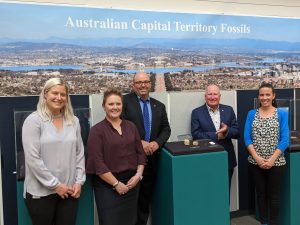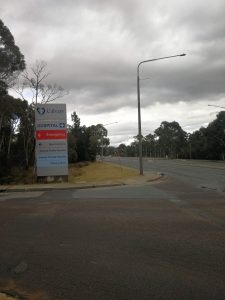Farming’s future in the Murray-Darling Basin
By GRACE KEYWORTH
FARMERS have been irrigating land in the Murray Darling Basin for more than a century. What does the future hold for the Basin?
Who lives there?
More than two million people live the Murray-Darling Basin according to the Australian Bureau of Statistics. The agricultural industry employs ten percent of these people, compared to three percent Australia wide. The highest employment rate has recently changed from Agriculture to Retail. Retail now employs fourteen percent of the working population in the Basin. Around 60 000 of Australia’s farms are in the basin, and just over 15 000 of them use irrigation.
Where is the Basin?
When people think of the Murray, usually their thoughts jump straight to the irrigation towns of Griffith and Mildura. In fact the basin spans across one million square kilometres and includes land in Queensland, New South Wales, Victoria, South Australia and the ACT.
Geographically this area starts in the north at Tambo in Queensland and also includes Roma and Toowoomba. It covers most of New South Wales includes towns such as Tamworth, Armidale, Broken Hill and Wagga Wagga. In Victoria the high profile towns of Albury, Echuca, and Swan Hill that dot the banks of the Murray itself are directly affected by the flows of the river. Renmark in South Australia along with Murray Bridge are also in the Basin. A note worthy city that is not in the Basin but relies heavily on it for its drinking water is Adelaide.
How much does the Basin produce?
Although the basin only covers ten percent of Australia, it produces forty percent of our agricultural output. The basin is commonly referred to as Australia’s food bowl, and these claims are generally correct.
The basin produces all of Australia’s rice and oranges and around half of its wheat, lamb, pork, apples and grapes. It also produces 15 percent of Australia’s cotton and a third of our beef. According to the Murray-Darling Basin Authority, only 360 square kilometres of the basin are used for fresh vegetable production. This is only one percent of the area of the Basin, but produces a quarter of Australian vegetables.
Three million Australians rely on the Murray-Darling system for their drinking water.
What problems does the Basin face?
Many environmental studies have found that the Basin has been stressed by the over allocation of its water resources. The blame has been firmly planted on the State Governments by allowing too much water to be taken out of the system for many years.
Associate Professor David Paton from Adelaide University said that they have known for two decades that the amount of water been taken out of the system was unsustainable.
“We should’ve started the process of reform, 10 or 20 years back to get the best outcome for this system,” he said. “The pain that people are going to experience now, and the environment has already experienced that pain- it’s deteriorated dramatically, is actually required now to make that difference.” Dr Paton said that a healthy river is integral to a sustainable irrigation system.
“If you have a healthy river then you have potential healthy irrigation systems and healthy communities along the river systems into the future.”
What is being done to fix these problems?
The Murray-Darling Basin Authority was established in 2007 to manage the Nation’s water resources in the national interest. Part of its responsibility under the Water Act is to come up with a plan that sets out the future water allocations for agriculture, industry and environment.
Importantly the Federal Water Act 2007 states that water for environmental needs must be given primacy and then the balance of the water shall be divided up for other purposes. This is unique internationally as no other country puts the environmental needs above those of industry and drinking water.
A lot of work has been done to improve irrigation technology to maximise its efficiency.
Professor Mike Young, from the Wentworth Group of concerned scientists, said that more work needs to be done to also make environmental water management efficient. “In the last two decades the irrigation industry has been revolutionary in terms of improving water management,” he said. “Environmental water management hasn’t made the same progress. We can get both sides right.”
The guide to the draft of the plan was released last week, which farmers have reacted angrily to the planned cuts to irrigation water. A group of farmers publicly burned the plan at a meeting in Deniliquin, claiming their livelihoods would be lost if the planned cuts are followed.
How much water does the Basin have to use?
The Bureau of Meteorology says the basin has an average rainfall of 480 millimetres per year. This equates to just over half a million gigalitres. The MDBA says most of this water is used by plants or evaporates, only 32 800 GL, or fifteen percent of it ends up in the river system. The Basin can store up to 35 000GL in its water storages. According to BOM it currently has 25 000 GL in storage.
How much water does the environment need.
The Murray Darling Basin Authority found that the environment in the basin needs at least 3000 Gigalitres a year more than what it is currently receiving to be sustainably healthy. The Murray Darling Basing Guide plan says that the environment in currently receiving 19 000GL a year on average. The proposed changes means that water to the environment will need to increase by at least six percent. The MDBA says that this amount should keep the mouth of the Murray open for eight out of 10 years. This year is the first year since 2002 that water has flowed out of the mouth of the river.
The basin has more than 30 000 wetlands of which sixteen are of international significance and recognised under the convention on the Wetlands of International Importance. The Willandra Lakes region is also classified as a World Heritage Place in 2007. These wetlands are essential breeding grounds and food sources for many species of waterbirds, fish and plants.
What do the cuts mean for farmers?
The MDBA says in the guide that the reduction in water allocation for agricultural purposes won’t mean that every farmer will lose twenty percent of their water. Instead the government will voluntarily acquire water licences and those licences will be withheld for environmental purposes. The MDBA predicts that this re-allocation will reduce the gross irrigated agricultural activity by $0.8- $1.1 billion. This will have obvious impact on the farming industry and the communities that depend on income from agriculture.



mikala
Feb 8, 2012 at 10:39 amwhat land does the murray darlin basin cover and what states does it pass through